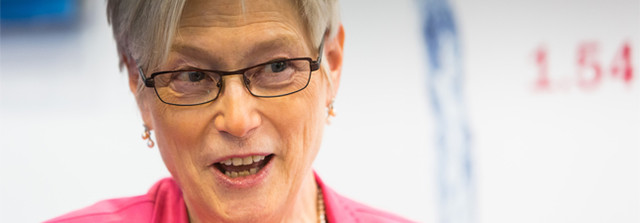Executive Director of the International Energy Agency, Maria van der Hoeven, talked to Sarah Azau at EWEA 2014 Annual Event in Barcelona about power markets, subsidies and the Crimea.
Will the Crimean situation make a difference to our relationship with Russian gas? Or are we simply too dependent on it?
We are quite dependent on fossil fuel imports, but rather than gas I would look to talk about coal – Europe is burning more coal, more lignite than before and gas is being squeezed between coal and renewables, as the price of gas is rather high. But diversifying your energy mix is always good for a region.
Christine Lagarde has spoken out strongly on fossil fuel subsidies recently. What is your view on her comments?
There are two types of subsidies – subsidies on consumption, which is where the IEA works, and on production, which is what the OECD works on. But we spent $544 billion on fossil fuel subsidies in 2012 – that is a huge amount!
We can see this everywhere, for instance in a number of oil producing countries like Saudi Arabia, also in big countries like China, India and so on. But some efforts are already being made.
However, fossil fuel subsidies distort the market, they encourage wasteful consumption, they are not useful.
The wind industry and other campaigners are calling for a renewable energy target of 30% at least for 2030 in the EU. In your speech at today’s opening session you said you welcomed a renewables energy target – is anything else needed?
Whenever there is a target, you need to have the instruments in place to meet that target, so if there are no EU national targets you will need a European mechanism to meet that target. We would like to see targets, we would like them to be clear and with a mechanism that can be implemented.
On infrastructure we don’t necessarily think there should be a target, but we want interconnectors between different markets or there won’t be a properly functioning market for energy. It is important to have an objective for interconnection and it must not be forgotten – at the moment it seems to be under the table. Europe needs to have flexibility, storage, and demand side measures. To have a good energy market in EU is of utmost importance.
In a recent report you found integrating 30 percent or more of annual electricity production from wind and solar PV into power systems can come at little additional cost in the long term. TSOs often say that they cannot integrate more wind because of the power system – what would your message to them and to EU governments be?
Let me say first that there is one precondition – in a stable system like Europe there is not much growth in power demand and there is overcapacity. In dynamic systems with growing power demand the situation is different, you can build your flexible system from the beginning, but in Europe you have to transform it. Some questions need to be answered – what are we going to do with most polluting power plants, how are we going to deal with stranded assets? Europe has to come up with an answer. But what is true is that by transforming your whole energy supply chain you can have flexibility, allowing variable renewables to grow.
How do you see the future of wind and renewable energy, in the EU and further afield?
That’s a difficult question – Europe was at the forefront of renewables and paid the price for that. But without Europe the renewables issue would not be as it is in other parts of the world. But if Europe wants to keep its front position in renewables is has to transform its energy system and develop a market for renewables. It can’t be done overnight, but it must be looked into to have a mature renewable energy sector.
By Sarah Azau


